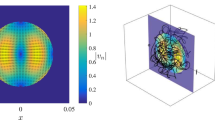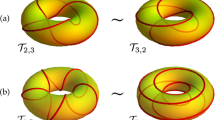Abstract
Knots and links have been conjectured to play a fundamental role in a wide range of physical fields, including plasmas and fluids, both quantum and classical. In fluids, the fundamental knottedness-carrying excitations occur in the form of linked and knotted vortex loops, which have been conjectured to exist for over a century. Although they have been the subject of considerable theoretical study, their creation in the laboratory has remained an outstanding experimental goal. Here we report the creation of isolated trefoil vortex knots and pairs of linked vortex rings in water using a new method of accelerating specially shaped hydrofoils. Using a high-speed scanning tomography apparatus, we measure their three-dimensional topological and geometrical evolution in detail. In both cases we observe that the linked vortices stretch themselves and then deform—as dictated by their geometrically determined energy—towards a series of local vortex reconnections. This work establishes the existence and dynamics of knotted vortices in real fluids.
This is a preview of subscription content, access via your institution
Access options
Subscribe to this journal
Receive 12 print issues and online access
$209.00 per year
only $17.42 per issue
Buy this article
- Purchase on Springer Link
- Instant access to full article PDF
Prices may be subject to local taxes which are calculated during checkout





Similar content being viewed by others
References
Witten, E. Quantum-field theory and the Jones polynomial. Commun. Math. Phys. 121, 351–399 (1989).
Faddeev, L. & Niemi, A. Stable knot-like structures in classical field theory. Nature 387, 58–61 (1997).
Manton, N. & Sutcliffe, P. M. Topological Solitons (Cambridge Univ. Press, 2004).
Smalyukh, I. I., Lansac, Y., Clark, N. A. & Trivedi, R. P. Three-dimensional structure and multistable optical switching of triple-twisted particle-like excitations in anisotropic fluids. Nature Mater. 9, 139–145 (2010).
Tkalec, U. et al. Reconfigurable knots and links in chiral nematic colloids. Science 333, 62–65 (2011).
Irvine, W. T. M. & Bouwmeester, D. Linked and knotted beams of light. Nature Phys. 4, 716–720 (2008).
Irvine, W. T. M. Linked and knotted beams of light, conservation of helicity and the flow of null electromagnetic fields. J. Phys. A 43, 385203 (2010).
Dennis, M. R., King, R. P., Jack, B., O’holleran, K. & Padgett, M. Isolated optical vortex knots. Nature Phys. 6, 118–121 (2010).
Chandrasekhar, S. & Kendall, P. C. On force-free magnetic fields. Proc. Natl Acad. Sci. USA 42, 1–5 (1956).
Woltjer, L. A theorem on force-free magnetic fields. Proc. Natl Acad. Sci. USA 44, 489–491 (1958).
Berger, M. A. Introduction to magnetic helicity. Plasma Phys. Control. Fusion 41, B167–B175 (1999).
Freedman, M. H. & Berger, M. A. Combinatorial relaxation of magnetic fields. Geophys. Astrophys. Fluid Dynam. 73, 91–96 (1993).
Moffatt, H. K. Degree of knottedness of tangled vortex lines. J. Fluid Mech. 35, 117–129 (1969).
Moffatt, H. K. Some developments in the theory of turbulence. J. Fluid Mech. 106, 27–47 (1981).
Ricca, R. L. & Berger, M. A. Topological ideas and fluid mechanics. Phys. Today 49, 28–34 (1996).
Barenghi, C. F. Knots and unknots in superfluid turbulence. Milan J. Math. 75, 177–196 (2007).
Babaev, E. Non-Meissner electrodynamics and knotted solitons in two-component superconductors. Phys. Rev. B 79, 1–6 (2009).
Bouligand, Y. Recherches sur les textures des états mésomorphes. 6 - Dislocations coins et signification des cloisons de Grandjean-Cano dans les cholestériques. J. Physique 35, 959–981 (1974).
Kambe, T. & Takao, T. Motion of distorted vortex rings. J. Phys. Soc. Jpn 31, 591–599 (1971).
Kida, S. A vortex filament moving without change of form. J. Fluid Mech. 112, 397–409 (1981).
Ricca, R. L., Samuels, D. & Barenghi, C. Evolution of vortex knots. J. Fluid Mech. 391, 29–44 (1999).
Proment, D., Onorato, M. & Barenghi, C. Vortex knots in a Bose–Einstein condensate. Phys. Rev. E 85, 1–8 (2012).
Ricca, R. New developments in topological fluid mechanics. Il Nuovo Cimento. 32, 185–192 (2009).
Thomson, W. On vortex atoms. Phil. Mag. 34, 94–105 (1867).
Moffatt, H. K., Kida, S. & Ohkitani, K. Stretched vortices—the sinews of turbulence; large-Reynolds-number asymptotics. J. Fluid Mech. 259, 241–264 (1994).
Acheson, D. J. Elementary Fluid Dynamics (Clarendon, 1990).
Saffman, P. G. Vortex Dynamics (Cambridge Univ. Press, 1992).
Calini, A., Keith, S. F. & Lafortune, S. Squared eigenfunctions and linear stability properties of closed vortex filaments. Nonlinearity 24, 3555–3583 (2011).
Kida, S. & Takaoka, M. Reconnection of vortex tubes. Fluid Dynam. Res. 3, 257–261 (1988).
Donnelly, R. J. Vortex rings in classical and quantum systems. Fluid Dynam. Res. 41, 051401 (2009) 1–31.
Douady, S. & Couder, Y. Direct observation of the intermittency of intense vorticity filaments in turbulence. Phys. Rev. Lett. 67, 983–986 (1991).
Thomson, W. XXIV. Vibrations of A Columnar Vortex 155–168 (Philosophical Magazine Series 5, Vol. 10, 1880).
Sethian, J. A. A fast marching level set method for monotonically advancing fronts. Proc. Natl Acad. Sci. USA 93, 1591–1595 (1996).
Deschamps, T. & Cohen, L. D. Minimal paths in 3D images and application to virtual endoscopy. Med. Image Anal. 5, 281–299 (2001).
Dengler, R. Self inductance of a wire loop as a curve integral. Preprint at http://arxiv.org/abs/1204.1486 (2012).
Oshima, Y., Kambe, T. & Asaka, S. Interaction of two vortex rings moving along a common axis of symmetry. J. Phys. Soc. Jpn 38, 1159–1166 (1975).
Acknowledgements
The authors acknowledge useful discussions with J. Burton, P. M. Chaikin, E. Efrati, H. M. Jaeger, H. K. Moffatt, S. R. Nagel, M. Scheeler, T. Witten and W. Zhang. We acknowledge MRSEC Shared Facilities at the University of Chicago (DMR-0820054) for the use of their instruments. This work was supported by the National Science Foundation (NSF) Materials Research and Engineering Centers (MRSEC) Program at the University of Chicago (DMR-0820054). W.T.M.I. further acknowledges support from the A.P. Sloan Foundation through a Sloan fellowship, and the Packard Foundation through a Packard fellowship.
Author information
Authors and Affiliations
Contributions
W.T.M.I. conceived and supervised research. W.T.M.I. and D.K. designed experiments and developed vortex generation and analysis techniques. D.K. developed the tomography apparatus and software, performed experiments and processed data. D.K. and W.T.M.I. analysed results and wrote the manuscript.
Corresponding authors
Ethics declarations
Competing interests
The authors declare no competing financial interests.
Supplementary information
Supplementary Information
Supplementary Information (PDF 326 kb)
Supplementary Movie
Supplementary Movie 1 (MOV 6651 kb)
Supplementary Movie
Supplementary Movie 2 (MOV 4302 kb)
Supplementary Movie
Supplementary Movie 3 (MOV 3006 kb)
Supplementary Movie
Supplementary Movie 4 (MOV 2071 kb)
Supplementary Movie
Supplementary Movie 5 (MOV 2081 kb)
Supplementary Movie
Supplementary Movie 6 (MOV 6007 kb)
Supplementary Movie
Supplementary Movie 7 (MOV 5939 kb)
Supplementary Movie
Supplementary Movie 8 (MOV 6749 kb)
Supplementary Movie
Supplementary Movie 9 (MOV 6039 kb)
Supplementary Movie
Supplementary Movie 10 (MOV 2818 kb)
Supplementary Movie
Supplementary Movie 11 (MOV 3216 kb)
Rights and permissions
About this article
Cite this article
Kleckner, D., Irvine, W. Creation and dynamics of knotted vortices. Nature Phys 9, 253–258 (2013). https://doi.org/10.1038/nphys2560
Received:
Accepted:
Published:
Issue Date:
DOI: https://doi.org/10.1038/nphys2560
This article is cited by
-
Topological atom optics and beyond with knotted quantum wavefunctions
Communications Physics (2024)
-
Polar Solomon rings in ferroelectric nanocrystals
Nature Communications (2023)
-
Scalar optical hopfions
eLight (2022)
-
Topological nature of the liquid–liquid phase transition in tetrahedral liquids
Nature Physics (2022)
-
Topologically protected vortex knots and links
Communications Physics (2022)



